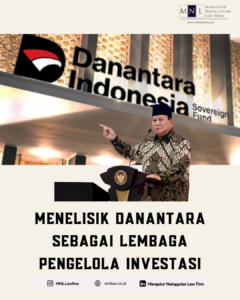
Danantara is an abbreviation of “Daya Anagata Nusantara.” President Prabowo Subianto explained that “Daya” symbolizes energy or strength, “Anagata” means future, and “Nusantara” represents Indonesia as a whole. Thus, Danantara functions as an economic entity and a strategic investment institution to support national development and economic growth.
Background and Legal Basis:
The government initiated the establishment of Danantara by drafting regulations as its legal foundation. The revision of Law Number 19 of 2003 concerning State-Owned Enterprises (BUMN) resulted in Law Number 1 of 2025, which was passed by the Indonesian House of Representatives (DPR RI) in early February 2025. To clarify its structure and management mechanisms, the government issued Government Regulation Number 10 of 2025. Following the enactment of these regulations, President Prabowo Subianto officially inaugurated Danantara on February 24, 2025.
Danantara’s Objectives:
Danantara was established as an investment management body aimed at optimizing state assets through strategic investments and enhancing competitiveness in the global market. With Danantara, Indonesia provides an attractive scheme for global investors. The institution consists of two main units: an operational holding and an investment holding. The operational holding is responsible for managing the operational activities of state-owned enterprises (BUMN) under its umbrella, while the investment holding focuses on managing state-owned assets and investments to increase their economic value.
According to the revised BUMN Law, Danantara Investment Management (BPI Danantara) has the authority to establish two parent companies. The shareholding structure in these entities consists of the Minister of BUMN holding one percent of the A Dwiwarna shares, while BPI Danantara holds the majority share of 99 percent in B-series shares.
Investment and Asset Management:
In its initial phase, Danantara will manage assets from the Indonesia Investment Authority (INA) and seven state-owned enterprises, namely Bank Mandiri, Bank BRI, PLN, Pertamina, BNI, Telkom Indonesia, and MIND ID. The initial managed funds from INA and these seven state-owned enterprises amount to approximately USD 600 billion or around IDR 9,729 trillion, with a target increase to USD 982 billion.
Danantara’s Organizational Structure:
Chairperson and Members:
Danantara is led by the Minister of BUMN, who also serves as a member. Other members come from the Ministry of Finance as well as officials or professionals appointed by the President. Their primary duties include overseeing Danantara’s operations, approving the annual budget and business plan (RKAP), evaluating performance, and reporting to the President.
Investment Holding (Investment & State-Owned Assets):
Comprising a President Director and at least one other director as determined by the General Meeting of Shareholders (RUPS), the requirements for directors include being an Indonesian citizen, a maximum age of 60 at the time of initial appointment, not being a political party official, and having 15 years of experience in the relevant field. The main responsibilities include managing state-owned investments and assets, preparing the RKAP, and proposing the removal of non-productive assets.
Supervisory Board:
The Supervisory Board reports to the President and consists of professionals in investment, economics, finance, or law. Their responsibilities include managing dividends and state-owned investments, formulating investment policies, and collaborating with third parties in asset management, with reporting obligations to both the Supervisory Board and the President.
Advisory Board:
The Advisory Board serves as a strategic advisor to Danantara and the government in managing state-owned enterprises. Members are experts appointed by the President based on their expertise in economics, business, and public policy.
Operational Holding (State-Owned Enterprises Operations):
This division consists of a President Director and at least one other director as determined by the RUPS. Their duties include managing state-owned enterprise operations, improving business efficiency and competitiveness, and preparing and proposing the RKAP to Danantara.
Advantages and Disadvantages of Danantara:
Advantages:
- Improved Governance: Danantara is expected to enhance transparency and governance of state assets.
- Long-Term Financial Stability: It has the potential to maintain the country’s financial stability in the long run.
- Economic Growth Driver: With a focus on priority sectors, Danantara is expected to be a catalyst for economic growth.
Disadvantages:
- Potential Bureaucratic Inefficiency: Additional hierarchical layers may slow down decision-making processes.
- Declining SOE Performance: Lengthy bureaucratic procedures might reduce the flexibility and innovation of state-owned enterprises.
- Political Issues: The emergence of Danantara amid various socio-political issues may generate negative sentiment.
Conclusion:
Danantara is an investment institution aimed at optimizing state asset management and driving economic growth. While it offers significant benefits, bureaucratic challenges and political issues remain concerns. Danantara’s success largely depends on the implementation of good governance, transparency, and commitment to addressing existing challenges.
